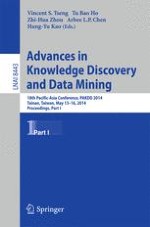The two-volume set LNAI 8443 + LNAI 8444 constitutes the refereed proceedings of the 18th Pacific-Asia Conference on Knowledge Discovery and Data Mining, PAKDD 2014, held in Tainan, Taiwan, in May 2014. The 40 full papers and the 60 short papers presented within these proceedings were carefully reviewed and selected from 371 submissions. They cover the general fields of pattern mining; social network and social media; classification; graph and network mining; applications; privacy preserving; recommendation; feature selection and reduction; machine learning; temporal and spatial data; novel algorithms; clustering; biomedical data mining; stream mining; outlier and anomaly detection; multi-sources mining; and unstructured data and text mining.
